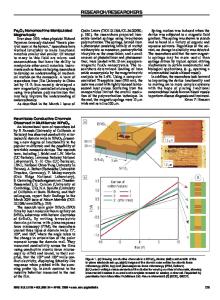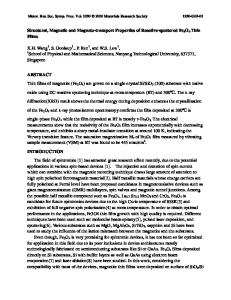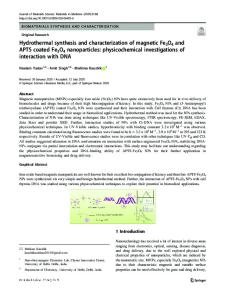Structural Studies of Pulsed-laser-deposited Ba 4 Fe 4 Ti 3 O 16 Oxide Films
- PDF / 1,420,349 Bytes
- 8 Pages / 612 x 792 pts (letter) Page_size
- 85 Downloads / 326 Views
R. Maier and J.L. Cohn Department of Physics, University of Miami, Coral Gables, Florida 33124
J.J. Neumeier Department of Physics, Florida Atlantic University, Boca Raton, Florida 33431 (Received 12 October 1999; accepted 24 March 2000)
For this paper the pulsed laser deposition on single-crystal MgO substrates of Ba4Fe4Ti3O16 target was studied by transmission electron microscopy and x-ray diffraction. The initial stage of the deposition resulted in the formation of the perovskite Ba(Fe,Ti)O3 phase in an epitaxial, cube-on-cube orientation relationship with a substrate. Further growth of the pseudo-cubic phase was interrupted by the formation of oriented grains with a disordered structure. This disordered structure had a mixture of lamellae of the cubic and hexagonal Ba(Fe,Ti)O3 phases. No formation of the Ba4Fe4Ti3O16 (E) phase was observed. Formation of the disordered phase was explained by the higher stability of hexagonal Ba(Fe,Ti)O3 where accommodation of Fe3+ occurred on a twinning plane. The development of the V-shape morphology and a limited number of orientations of the D structure were explained by the faceting and columnar morphology of the perovskite phase.
I. INTRODUCTION
The perovskite oxide barium titanate, BaTiO3, is a promising material for different electro-optic and memory applications.1 Most applications utilize highdielectric permittivity and ferroelectric properties of the material. Doping of BaTiO3 results in a large photorefractive effect that can be utilized in optical memory and optical-processing devices.2 Therefore, the effect of ternary additions on the structure of BaTiO3 is of technological interest. In a recent study of the BaO:Fe2O3:TiO2 system, numerous ternary compounds were found.3 Among these compounds, a group of six ferromagnetic phases (designated as E, M, N, K, L, and J in that paper) was identified as having an ordered intergrowth structure.4,5 These very complex structures with a high degree of stacking order can be synthesized either by solid-state diffusion at 1250 °C from the basic components or by crystal growth using fluxes. The intergrowth layers were identified as (i) type P (low in Fe) with a structure having a hexagonal modification of a cubic perovskite, and (ii) type H (high in Fe) with two structural modifications, both related to the structure of magnetite. The thickness of the P-type layer (the number of close-packed layers of BaO3) varies with the composition of the phases. The hexagonal (h) J. Mater. Res., Vol. 15, No. 6, Jun 2000
http://journals.cambridge.org
Downloaded: 11 Apr 2015
modification, h-BaTiO3, is a high-temperature polymorph of the cubic perovskite, and its structure can be viewed as repetitive (111) twinning of the cubic ABC– ABC structure every fourth close-packed layer CABCBACABC.6 The twinning plane coincides with the BaO3 layer and creates face-sharing octahedra. It has been shown 3,7 that Fe stabilizes the high-temperature h-BaTiO3 to lower temperature, and a large field of h-Ba(Ti,Fe)O3 exists along a BaTiO3–BaFeO2 section of t
Data Loading...











